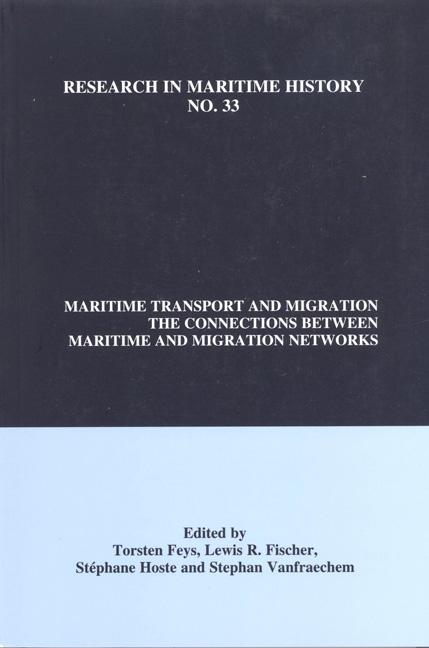Book contents
- Frontmatter
- Contents
- Contributors' Notes
- “Migration and Maritime Networks in the Atlantic Economy: An Introduction”
- “The First Waves of Internationalization: A Comparison of Early Modern North Sea and Nineteenth-Century Transatlantic Labour Migrations”
- “The Battle for the Migrants: The Evolution from Port to Company Competition, 1840-1914”
- “The Role of Foreign-bora Agents in the Development of Mass Migrant Travel through Britain, 1851-1924”
- “Transatlantic Emigration and Maritime Transport from Greece to the US, 1890-1912: A Major Area of European Steamship Company Competition for Migrant Traffic”
- “The ‘Relatives and Friends Effect:’ Migration Networks of Transatlantic Migrants from the Late Habsburg Monarchy”
- “Crossing the Last Frontier: Transatlantic Movements of Asian Maritime Workers, c. 1900-1945”
- “Costs, Risks and Migration Networks between Europe and the United States, 1900-1914”
- “Conclusion”
“Conclusion”
- Frontmatter
- Contents
- Contributors' Notes
- “Migration and Maritime Networks in the Atlantic Economy: An Introduction”
- “The First Waves of Internationalization: A Comparison of Early Modern North Sea and Nineteenth-Century Transatlantic Labour Migrations”
- “The Battle for the Migrants: The Evolution from Port to Company Competition, 1840-1914”
- “The Role of Foreign-bora Agents in the Development of Mass Migrant Travel through Britain, 1851-1924”
- “Transatlantic Emigration and Maritime Transport from Greece to the US, 1890-1912: A Major Area of European Steamship Company Competition for Migrant Traffic”
- “The ‘Relatives and Friends Effect:’ Migration Networks of Transatlantic Migrants from the Late Habsburg Monarchy”
- “Crossing the Last Frontier: Transatlantic Movements of Asian Maritime Workers, c. 1900-1945”
- “Costs, Risks and Migration Networks between Europe and the United States, 1900-1914”
- “Conclusion”
Summary
Oddly enough, migration historians and maritime historians have often written about transoceanic crossings like two ships passing in the night. In November 2005, historians from the two fields met in Florence to discuss what each could learn from the other and how, together, they could advance our understanding of the great cross-Atlantic migrations of the long nineteenth century. Such is the provenance of the articles in this volume. Not surprisingly, a number of the articles still bear the imprint of their author's first identification. Jelle van Lottum and Annemarie Steidl have written about patterns of migration over time and space. Others have concentrated on port cities and shipping companies, but have framed these within the history of the emigration trades. In either case, however, there are recurrent themes and questions that show how entangled, and thus mutually informative, the histories of peoples and seas can be.
Debates over causal factors force us to think about some of these. We know that several tens of millions of Europeans left farms, villages or towns and sailed across an ocean to a foreign land between 1820 and 1914. But what determined why they went and where they ended up? And more important, in the context of the bringing together of maritime and migration scholars, what role did maritime institutions - shipping companies, ports, and commercial agents - play in this decision-making process? At one end of the spectrum, the answer is not necessarily much at all, except to facilitate or prosper from a passage already pre-determined. Van Lottum, whose insightful comparison across centuries concerns primarily early modern times but is not unconnected to nineteenth-century migration, stresses push-and-pull factors, mostly of a demographic and economic nature. Steidl's refined analysis of patterns of departures from the Austrian half of the Habsburg Empire after 1870 lays out the classic migrationist case. Emigration occurred through a chain migration predicated on information and support networks provided by family and friends. These migrants clearly did not walk across the Atlantic, but otherwise neither ships nor shipping companies need be brought into the picture. Drew Keeling writes a great deal about shipping companies, but his judgements are, with modifications, comparably restrictive. Without regular steamship services there would have been no massive emigration.
- Type
- Chapter
- Information
- Maritime Transport and MigrationThe Connections Between Maritime and Migration Networks, pp. 175 - 184Publisher: Liverpool University PressPrint publication year: 2007



